The ASUS ZenBook 3 Review: A Convincing Case for Quad Core Thin & Light Laptops
by Brett Howse on November 22, 2017 8:00 AM EST- Posted in
- Laptops
- Asus
- Zenbook
- Core 8th Gen
- Kaby Lake Refresh
Battery Life
Battery life is something that everyone needs, but is also one of the hardest aspects of a laptop to measure since everyone has different tasks they want to perform. To get consistent results, all devices are set to 200 nits of brightness prior to the test being run. All devices are tested with Edge as the browser.
We have three tests that we are utilizing in our test suite right now. The 2013 Light test is our older web browser test, which is the lightest test, and it opens four web pages per minute. It’s reached a point where it's a bit too light for most devices, but it’s also the one with the most backlog of results to compare against, so it’s nice to test it still. The 2016 Web test is a much more demanding web test, which is the same one we use on our mobile devices. Finally, we test video playback from a local h.264 video file.
The ASUS Zenbook is equipped with just a 46 Wh battery, which is about the same size as the Surface Pro, and on the small size for an Ultrabook. A new XPS 13, for example, is a relatively massive 60 Wh, so expectations are tempered going into our testing.
2013 Light Results

On our 2013 test, the ZenBook 3 did very well. 11.25 hours of battery life out of just 46 Wh is well above expectations. It can’t quite match the FHD version of the Dell XPS 13 we tested (this is the original Broadwell version – Dell will be sending us the latest gen one soon for a more up-to-date result), but it’s still a great result for having a below average capacity battery in an Ultrabook.
2016 Web Results
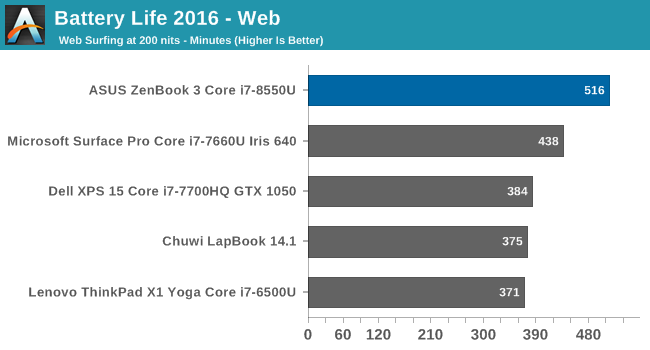
The more demanding web browsing test does knock some time off the result, but the ZenBook 3 is the longest lasting device we’ve tested with this version of the benchmark. It’s a very impressive result.
Normalized Results

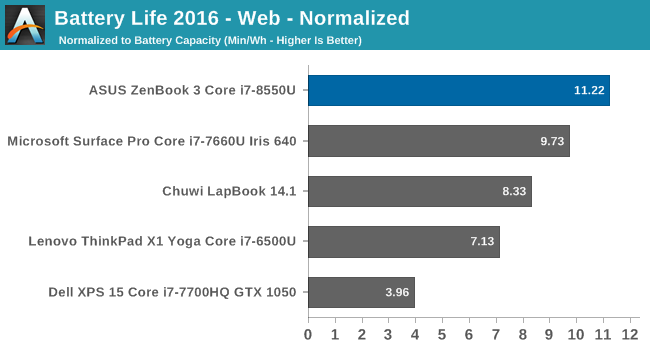
By removing the battery capacity from the equation, we can see how efficient each device is. Here the lower resolution display helps out a lot, but overall, ASUS has done a great job on power management. The ZenBook 3 is one of the most efficient laptops we’ve seen.
Movie Playback
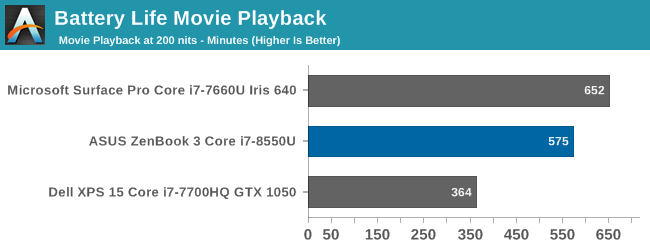
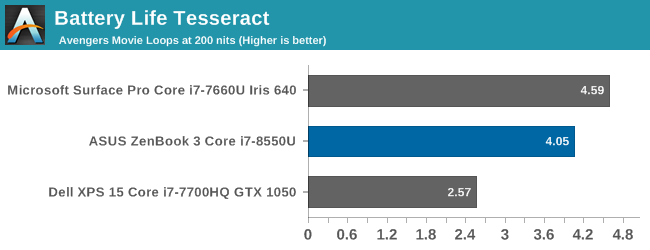
Movie playback is not quite as impressive as the Surface Pro, but still quite strong.
Charge Time
The other side of the mobility equation is charge time. ASUS ships the ZenBook 3 with a 65-Watt USB-C AC Adapter. The wattage of this charger is quite a bit higher than most other Ultrabooks, where 40-Watts or so is much more common. Also, ASUS has added upstream charging to all three of the USB-C ports on the notebook, so you can charge it on whichever one is the most convenient. Not all companies do this, so ASUS needs to be commended here.
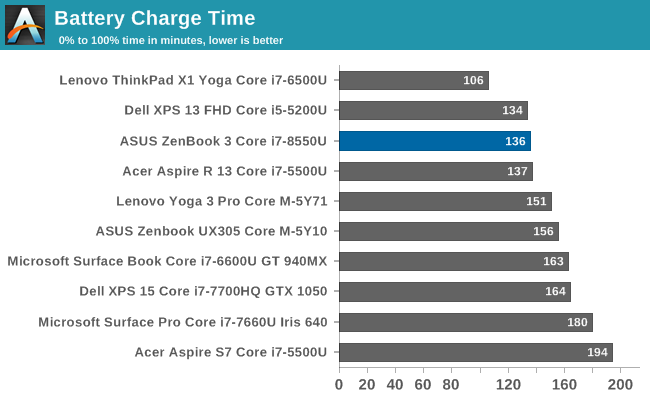
The ZenBook 3 charges from dead to full in just a hair over two hours, which is one of the quickest we’ve seen. Looking at the charge graph, it hits 50% charge in just 43 minutes, so the larger charger does help on the quick fill-up.











55 Comments
View All Comments
aeronatis - Wednesday, November 22, 2017 - link
I believe they prefer to implement LPDDR to be able to reach long battery runtime during sleep. With standart DDR, any sleeping computer is pretty much out of juice overnight whereas laptops with LPDDR can sleep for days.DanNeely - Wednesday, November 22, 2017 - link
I've been able to sleep Dell Latitudes used by my previous employer over the weekend since the 2008(?) models; AFAIK all of them used standard DDR2/3 not low power sorts.hybrid2d4x4 - Thursday, November 23, 2017 - link
Overnight? That's a pretty major exaggeration. I had a Acer 3830TG (Sandy bridge, 4GB DDR3) that lasted >3 weeks in sleep. And before anyone says it, I always "powercfg -h off" on a new system/OS install.wolrah - Wednesday, November 22, 2017 - link
@labrats5 Who said anything about LPDDR3?@Jimios basically I'm looking for a powerful, portable machine on which to run VMs and do development. It'll never run games or even Windows so an nVidia or AMD GPU is just wasted silicon, wasted power, and annoying driver problems. I'd rather just use the Intel GPU that's built in to the processor and has great Linux support, but basically every proper workstation laptop forces a Quadro on you.
If I want to avoid the GPU I'm stuck looking at the thinner models. I don't really care about thin, I think my 2008-era Macbook Pro (the one right before unibody, that was basically an evolution of the Powerbook G4 design) was perfect as far as size/weight goes.
Jimios - Wednesday, November 22, 2017 - link
Can't the dGPU be completely disabled through BIOS/EFI or something? I haven't owned a non-Apple laptop recently so I honestly don't know.As for your use case (multiple VMs, etc.), I understand, but I don't think there would be too much demand for what you're asking. A laptop with your description wouldn't sell well to justify the development and marketing cost, IMO. Laptops like the article we're commenting on are mass market devices.
Also, typically with "workstation laptops" companies aim at CAD/CAM engineers and creative professionals. Which is sad, and I understand your frustration.
DanNeely - Wednesday, November 22, 2017 - link
As a developer currently using a Yoga with 16GB of ram, while I'd rather have a big laptop with a 45W CPU and 32GB of ram; if I could only have 1 I'd go for the ram multiple VMs or copies o Visual studio and a bunch of loaded browsers max out 16GB more often than I'm CPU limited.wolrah - Wednesday, November 22, 2017 - link
"Can't the dGPU be completely disabled through BIOS/EFI or something? I haven't owned a non-Apple laptop recently so I honestly don't know."I have yet to encounter a dual-GPU laptop where all the video ports were wired through the onboard GPU. Usually at least one of the external ports and sometimes the internal display is wired through the dedicated component, requiring that part to be enabled for those ports to work.
On my current Asus with a GT650M the HDMI port is wired through the nVidia chip so if I want to use an external monitor I have to either use VGA (yuck) or deal with the disaster that is nVidia Optimus. Even under Windows it's annoying, under Linux it's a mess.
linuxgeex - Thursday, November 23, 2017 - link
I've felt the same as you for the last decade, but you'd be surprised these days. AMD GPUs are quite well supported out of the box on open drivers, within 6mo of launch, and generally you can get them up on launch day using recent kernel/Mesa releases. I'll be getting an AMD 2500u based laptop this time around. Probably the Acer Swift.timecop1818 - Thursday, November 23, 2017 - link
> basically I'm looking for a powerful, portable machine on which to run VMs and do development. It'll never run games or even Windows so an nVidia or AMD GPU is just wasted silicon, wasted power, and annoying driver problems. I'd rather just use the Intel GPU that's built in to the processor and has great Linux support, but basically every proper workstation laptop forces a Quadro on you.you had me until "never runs Windows", lol.
nice troll, bro, nice troll.
also, accelerated graphics support in lunix. ha ha ha ha ha.
thanks for the laugh.
IGTrading - Wednesday, November 22, 2017 - link
It will be lovely to watch AMD Ryzen Mobile mop the floor with this 1700 USD waste of money.For this much money, I would expect way better performance, but luckily HP Envy x360z with Ryzen Mobile is just 600 USD.
There's nothing in ASUS' new Zen that's worth the extra 1000 USD they're asking.